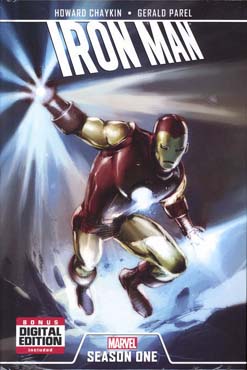(Another repost to fit in chronologically with my Silver Age reread).
Howard Stark’s first appearance highlights how working in a shared universe is different from just writing stuff by yourself. A writer (Archie Goodwin in this case) can introduce a little throwaway detail they obviously don’t consider important. Then someone else seizes on it and makes it a bigger thing, then someone else seizes it and makes it bigger yet. Howard Stark is a perfect example. In a sense, Howard embodies the American dream: he started a nobody and worked his way up to greatness.
Rereading the late Silver Age Iron Man me appreciate what a great job Goodwin did following Stan Lee on the title. Under Goodwin, Tony got his first serious love interest, Janice Cord (not a memorable one, admittedly), and faced several new villains such as the Controller, Madame Masque and Firebrand.

In what felt like a real game-changer at the time, Goodwin also replaced Tony’s damaged, always-on-the-brink-of-stopping heart with a more dependable artificial one. It was still fragile enough he contemplated hanging up the armor (as detailed at the link) before realizing, of course, that as long as the world needs Iron Man, he’s got go to on Ironing (hmm, that doesn’t sound quite right).

By contrast, the introduction of Howard Stark was nothing. A single panel in Iron Man #28, an issue in which Tony discovers his first sweetheart, Meredith McCall, is threatened by the Controller. In flashback we learn Meredith was the daughter of one of Howard’s chief rivals. Both dads refuse to let their kids do the Romeo and Juliet thing, so Tony and Meredith were shipped off, he to Europe, she to relatives
Up to that point, Marvel had presented Tony as a self-made man. Reading Stan’s run on the book, there’s no reference to Tony’s parents or any hint Tony wasn’t 100 percent responsible for his own success. IM #28 established Tony inherited leadership of the family business. Not that this made Tony any less brilliant, of course. Based on that single panel, there’s no reason to think Howard has any engineering skills at all. He could just as easily be a money man who built Stark Industries by hiring the best tech people.
Goodwin certainly didn’t see Howard as a big deal. He’s only there to give Meredith and Tony a backstory. Over time, though, Howard Stark has become a much more prominent character, a gifted engineer in his own right. Part of that is the sliding timescale of the MU. Back in the Silver Age it would be simple enough to have Tony Stark whipping up a gadget in a retcon 1950s story, but not now. Howard Stark fills the gap.

Another factor is Tony’s transformation from superstar entrepreneur to drunken, irresponsible party animal, which gives writers an incentive to portray Howard as his opposite, the grown-up in the room. In Iron Man: Season One, Howard’s death has everyone wondering whether drunken jackass Tony Stark can possibly fill shoes as big as his father’s.
A third factor is that Marvel’s doing increasing number of retcon series extending the modern heroic age back to the Golden Age. Howard Stark has worked with the V-Battalion. With the Brotherhood of the Shield. He helped out the 1959 Avengers. The more Howard does, the more his profile rises, and the more he gets reused. One story even gave him his own team of adventurers, Stark’s Seven, including Thunderbolt Ross and Jimmy Woo.
And then there’s the movies and Agent Carter, which have exposed Howard to the mass audience.
As the MU timeline continues to stretch I imagine we’ll end up with Howard’s dad, Howard Stark Sr. filling the same role in the 1950s and Howard Jr. getting Tony’s origin in Vietnam. Though by that point I may not be around to read it.
Art by Don Heck, Year One cover by Gerald Parel

